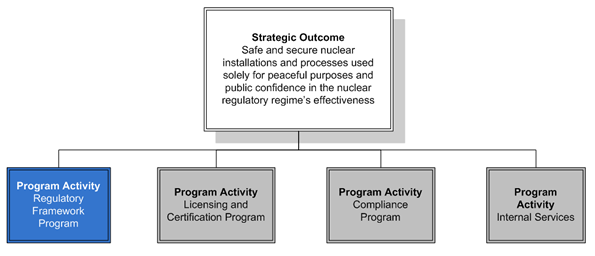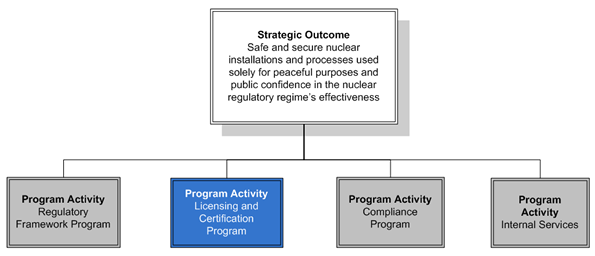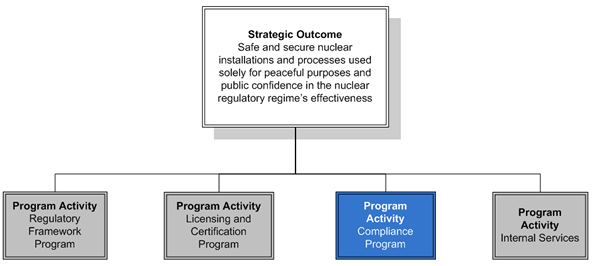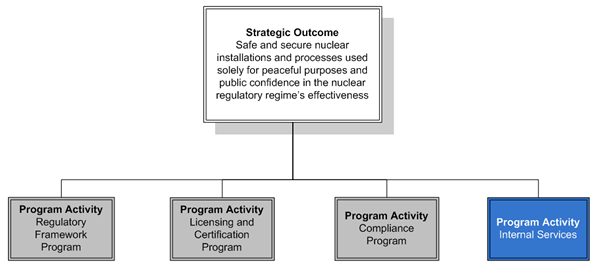Common menu bar links
Breadcrumb Trail
ARCHIVED - Canadian Nuclear Safety Commission - Report
 This page has been archived.
This page has been archived.
Archived Content
Information identified as archived on the Web is for reference, research or recordkeeping purposes. It has not been altered or updated after the date of archiving. Web pages that are archived on the Web are not subject to the Government of Canada Web Standards. As per the Communications Policy of the Government of Canada, you can request alternate formats on the "Contact Us" page.
Section II: Analysis of Program Activities by Strategic Outcome
Strategic outcome
The CNSC has a single strategic outcome: safe and secure nuclear installations and processes used solely for peaceful purposes and public confidence in the nuclear regulatory regime’s effectiveness. To support this outcome, the CNSC has four program activities: Regulatory Framework, Licensing and Certification, Compliance, and Internal Services.
The following section describes the CNSC’s program activities and identifies the expected results, performance indicators and targets for each of them. It also presents the financial and human resources that will be dedicated to each activity, and explains planning highlights.
Program Activity: Regulatory Framework

| 2012-13 | 2013-14 | 2014-15 |
|---|---|---|
| 28,041 | 28,719 | 29,847 |
| 2012-13 | 2013-14 | 2014-15 |
|---|---|---|
| 173 | 173 | 173 |
| Program Activity Expected Results | Performance Indicators | Targets |
|---|---|---|
| A clear and pragmatic regulatory framework. | Number of legal challenges to the regulatory framework. | Zero challenges, or high success rate of defending challenges. |
Program activity description
The Regulatory Framework program is in place to ensure that Canada has a clear and pragmatic regulatory framework for the nuclear industry in Canada.
Funds are used to develop and make improvements to elements of the regulatory framework (such as the Nuclear Safety Control Actand regulations under the Act; regulatory documents, such as policies, standards and guides; the Safeguards Agreement and Additional Protocol between Canada and the International Atomic Energy Agency; and Canada’s bilateral nuclear cooperation agreements) that protect the health, safety, security and environment for Canadians, while implementing Canada’s international commitments on the non-proliferation of nuclear weapons and the peaceful use of nuclear energy.
The CNSC also designates installations under the Nuclear Liability Act and, as a responsible authority under the Canadian Environmental Assessment Act, carries out environmental assessments for nuclear projects in accordance with this legislation.
The following table aligns the Regulatory Framework planning highlights with their corresponding organizational priorities, and presents the planned timeline for completion.
| Planning Highlights | Timeline for Completion |
|---|---|
| Negotiate new and amended bilateral nuclear cooperation agreements and administrative arrangements: | |
|
March 2013 |
| Consult on a policy on fitness for duty (drug and alcohol testing ) at major nuclear facilities. | March 2013 |
| Consult on a policy on safety culture in Canada’s nuclear industry. | March 2013 |
| Implement a renewed CNSC Research Program. | March 2013 |
| Planning Highlights | Timeline for Completion |
|---|---|
| Implement the staff action plan on the CNSC Fukushima Task Force recommendations. The action plan will focus on the following 3 categories: | |
|
Dec. 2015* |
|
Dec. 2013* |
|
Dec. 2015* |
| Respond to the Government of Canada’s Regulatory reform initiatives: | |
|
March 2013 |
|
Strengthen CNSC consultation practices related to regulatory initiatives. |
March 2013 |
| Establish implementation plans for MOUs with: | |
|
March 2013 |
|
March 2013 |
| Planning Highlights | Timeline for Completion |
|---|---|
| Continue modernization of the Regulatory Framework Plan, including: | |
|
March 2013 |
|
March 2013 |
|
March 2013 |
|
June 2012 |
|
March 2013 |
|
March 2013 |
|
March 2013 |
| Planning Highlights | Timeline for Completion |
|---|---|
| Deliver the CNSC 101 course, an information session on what and how the CNSC regulates, to communities across Canada. | Ongoing |
* Under the three categories there are specific actions to address the 13 Task Force Recommendations. These dates represent the final actions to close a category. For further details please see the full CNSC Staff Action Plan on the CNSC Fukushima Task Force Recommendations.
Program Activity: Licensing and Certification

| 2012-13 | 2013-14 | 2014-15 |
|---|---|---|
| 20,150 | 20,692 | 21,477 |
| 2012-13 | 2013-14 | 2014-15 |
|---|---|---|
| 143 | 143 | 143 |
| Program Activity Expected Results | Performance Indicators | Targets |
|---|---|---|
| Licences and certificates issued as per regulatory requirements. | Application completeness notifications and licensing decisions are issued within time lines defined by external performance standards. | Per external performance standards. For complete details please see the External Performance Standards table in “Section IV: Other Items of Interest”. |
Program activity description
The Licensing and Certification program is in place to issue licences or certify persons, and prescribed equipment for conducting nuclear-related activities in Canada.
With this program activity’s funding, the CNSC obtains evidence of an applicant’s ability to operate safely and comply with all regulatory requirements.
The CNSC undertakes this work to obtain assurance that nuclear activities and facilities in Canada are managed with adequate provision for protection of the health, safety and security of Canadians and the environment, and the fulfillment of international commitments to the peaceful use of nuclear energy.
The following table aligns the Licensing and Certification planning highlights with their corresponding organizational priorities, and presents the planned timeline for completion.
| Planning Highlights | Timeline for Completion |
|---|---|
| Conduct licence application assessments (including environmental assessments) for new major nuclear projects (power reactors, uranium mines and mills, waste management facilities): | |
|
March 2013 |
|
March 2013 |
|
March 2013 |
|
March 2013 |
| Continue regulatory oversight (licensing, certification and compliance verification) for more than 2,500 licensees of nuclear substances, prescribed equipment and Class II nuclear facilities involved in medical, industrial, commercial and academic settings. | Ongoing |
| Implement regulatory oversight (licensing, certification and compliance verification) of low-energy accelerators. | March 2014 |
| Extend requirement for financial guarantees to Class II nuclear facilities and users of nuclear substances and prescribed equipment. | March 2014 |
| Support Joint Review Panel for the Deep Geologic Repository. | March 2013 |
| Undertake regulatory reviews of applications for licence renewals, under the new licence format and licence condition handbook for: |
|
|
Dec 2012 |
|
May 2012 |
|
June 2012 |
| Undertake regulatory reviews of applications to consolidate and renew Pickering A and Pickering B power reactor operating licences (hearings). | June 2013 |
| Provide regulatory oversight of the Fuel Channel Life Management Project applicable for the continued operation at Pickering B, Darlington, Bruce A and Bruce B. | Ongoing |
| Implement the Fukushima Action Plan. | Ongoing |
| Provide regulatory oversight for refurbishment projects: | |
|
Ongoing |
|
Ongoing |
|
Ongoing |
|
March 2013 |
|
Nov. 2012 |
|
July 2013 |
| Continue regulatory oversight of the Port Hope Area Initiative. | Ongoing |
| Undertake regulatory reviews for non-reactor applications for medical isotopes. | Ongoing |
| Planning Highlights | Timeline for Completion |
|---|---|
| Implement licence reform for uranium mines and mills. | Sept 2013 |
| Continue analysis of aging on reactor operation, including fitness for service and development of a strategy for the preservation of safety margins. | Ongoing |
| Planning Highlights | Timeline for Completion |
|---|---|
| Undertake vendor design reviews: | |
|
June 2013 |
|
March 2013 |
|
January 2014 |
Program Activity: Compliance

| 2012-13 | 2013-14 | 2014-15 |
|---|---|---|
| 36,412 | 37,427 | 38,828 |
| 2012-13 | 2013-14 | 2014-15 |
|---|---|---|
| 271 | 271 | 271 |
| Program Activity Expected Results | Performance Indicators | Targets |
|---|---|---|
| Licensees comply with the regulatory framework. | Compliance activity reports issued to licensees within timelines defined by external performance standards. | Per external performance standards. For complete details please see the External Performance Standards table in “Section IV: Other Items of Interest”. |
Program activity description
The Compliance program is in place to ensure that CNSC licensees exhibit a high level of compliance with the CNSC’s regulatory framework. This program enables the CNSC to provide regulatory assurance to Canadians of the continuing compliance and safety performance of licensees.
This program activity’s funding is used for: ensuring licensees fully understand how to achieve compliance, promoting the development and maintenance of a sound safety culture and common safety values, verifying compliance through inspections and other assessments of licensee performance, and taking enforcement actions on observed non-compliance.
The following table aligns the Compliance planning highlights with their corresponding organizational priorities, and presents the planned timeline for completion.
| Planning Highlights | Timeline for Completion |
|---|---|
| Continue compliance verifications and enforcement activities for nuclear facilities, uranium mines and mills, and users of nuclear substances and prescribed equipment in Canada. | Ongoing |
| Planning Highlights | Timeline for Completion |
|---|---|
| Introduce electronic submission of nuclear material accountancy information. | March 2013 |
| Introduce electronic submission of annual compliance reports for Class II nuclear facilities and users of nuclear substances and prescribed equipment. | March 2013 |
| Implement an Independent Environmental Monitoring Program. | March 2013 |
| Enhanced mandatory reporting by Power Reactor Licensees through the implementation of RD-99.1, Reporting Requirements for Operating Nuclear Power Plants. | March 2013 |
| Enhanced proactive disclosure by Power Reactor Licensees, Class I nuclear facilities, Uranium Mines and Mills and certain Class II Nuclear Facilities through the implementation of RD/GD-99.3, Requirements and Guidance for Public Information and Disclosure. | Ongoing |
| Conduct verifications against Fukushima Action Plan. | Ongoing |
Program Activity: Internal Services

| 2012-13 | 2013-14 | 2014-15 |
|---|---|---|
| 39,226 | 40,057 | 41,692 |
| 2012-13 | 2013-14 | 2014-15 |
|---|---|---|
| 210 | 210 | 210 |
| Program Activity Expected Results | Performance Indicators | Targets |
|---|---|---|
| Activities and resources administered to support the needs of programs and other corporate obligations. |
Program activity description
Internal services are activities and resources that apply across the organization to directly and indirectly support program delivery and to meet other corporate obligations of the CNSC, as an agency of government.
These activities are: management and oversight (including audits and evaluations), communications, legal services, human resources management, financial management, information management, information technology, real property and materiel acquisition, travel and other administrative services.
The following table aligns the Internal Services planning highlights with their corresponding organizational priorities, and presents the planned timeline for completion.
| Planning Highlights | Timeline for Completion |
|---|---|
| Implement renewed CNSC engagement and corporate communications strategies. | March 2013 |
| Complete the Management Accountability Framework Assessment. | March 2013 |
| Planning Highlights | Timeline for Completion |
|---|---|
| Focus on management excellence by strengthening information to support decision making for: | |
|
Ongoing |
|
Ongoing |
|
Ongoing |
| Implement responses to the performance management framework audit and evaluation. | March 2013 |
| Planning Highlights | Timeline for Completion |
|---|---|
| Focus Human Resources activities on retention and training, specifically: | |
|
Ongoing |
|
Ongoing |
| Focus Information Management and Technology capacity on delivering priorities identified in the three-year Information Management and Technology strategic plan, specifically the development of e-services solutions. | Ongoing |
| Continue development of the financial guarantees program for non Class I licensees. | Ongoing |
| Obtain industry standard certification for the CNSC Laboratory Phase II extension to the analytical laboratory. | March 2013 |
| Planning Highlights | Timeline for Completion |
|---|---|
| Implement the Web accessibility directive. | July 2013 |
| Improve accessibility of information about the CNSC via electronic media innovation. | Ongoing |
